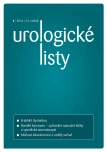Possibilities of surgical treatment of erectile DYSFUNCTION – development and current possibilities
Authors:
M. Nussir
Authors‘ workplace:
Urologická klinika FN Brno a LF MU
Published in:
Urol List 2014; 12(1): 24-28
Overview
As a result of the worldwide increase in the incidence of erectile dysfunction (ED) and the available minimally invasive alternative treatments (PDE‑ 5 inhibitors, intracavernosal injections, vacuum equipments, and the use of extracorporeal schockwaves), surgical treatment of ED remains the gold standard and an attractive solution for erectile dysfunction of organic cause in patients where conservative treatments have failed. This article assesses the role and development of surgical treatment of ED.
Keywords:
surgical treatment, erectile dysfunction
Sources
1. Setter SM, Iltz JL, Fincham JE et al. Phosphodiesterase 5 inhibitors for erectile dysfunction. Ann Pharmacother 2005; 39(7– 8): 1286– 1295.
2. Burnett AL, Aus G, Canby‑ Hagino ED et al. Erectile function outcome reporting after clinically localized prostate cancer treatment. J Urol 2007; 178(2): 597– 601.
3. Penson DF, McLerran D, Feng Z et al. 5‑year urinary and sexual outcomes after radical prostatectomy: results from the Prostate Cancer Outcomes Study. J Urol 2008; 179 (5 Suppl): S40– S44. doi: 10.1016/ j.juro.2008.03.136.
4. Ayta IA, McKinlay JB, Krane RJ. The likely worldwide increase in erectile dysfunction between 1995 and 2025 and some possible policy consequences. BJU Int 1999; 84(1): 50– 56.
5. Feldman HA, Goldstein I, Hatzichristou DG et al. Impotence and its medical and psychosocial correlates: results of the Massachusetts Male Aging Study. J Urol 1994; 151(1): 54– 61.
6. National Institute of Diabetes and Digestive and Kidney Diseases. National Kidney and Urologic Diseases Information Clearinghouse – Erectile dysfunction. Available from: http:/ / kidney.niddk.nih.gov.
7. Lue TF, Hon S. Pathophysiology of erectile dysfunction. Campbell‑ Walsh Urology: Elsevier Inc 2000: 688– 670.
8. Pacík D. Penilní protézy: jejich místo v léčbě erektilní dysfunkce a vlastní dlouhodobé zkušenosti. Urolog pro Praxi 2005; 1: 18– 22.
9. Bogoraz NA. On complete plastic reconstruction of a penis sufficient for coitus (in Russian). Soviet Surgery (Sovetskaya) 1936; 8: 303– 309.
10. Goodwin WE, Scott WW. Phalloplasty. J Urol 1952; 68(6): 903– 908.
11. Scott FB, Bradley WE, Timm GW. Management of erectile impotence: use of implantable inflatable prosthesis. Urology 1973; 2(1): 80– 82.
12. Small MP, Carrion HM, Gordon JA. Small‑Carrion penile prosthesis. New implant for management of impotence. Urology 1975; 5(4): 479– 486.
13. Finney RP. New hinged silicone penile implant. J Urol 1977; 118(4): 585– 587.
14. Jonas U, Jacobi GH. Silicone‑ silver penile prosthesis: description, operative approach and results. J Urol 1980; 123(6): 865– 867.
15. Finney RP. Flexi‑ flate penile prosthesis. Semin Urol 1986; 4(4): 244– 246.
16. Carson CC. Penile prostheses: are they still relevant? BJU Int 2003; 91(3): 176– 177.
17. Moncada I, Martinez‑ Salamanca JI, Allona A et al. Current role of penile implants for erectile dysfunction. Curr Opin Urol 2004; 14(6): 375– 380.
18. Jain S, Bhojwani A, Terry TR. The role of penile prosthetic surgery in the modern management of erectile dysfunction. Postgrad Med J 2000; 76(891): 22– 25.
19. Montague DK, Angermeir KW. Sugical approaches for penile prosthesis implantation: penoscrotal vs infrapubic. Int J Impot Res 2003; 15 (Suppl 5):S134– S135.
20. Kaufman JM, Kaufman JL, Borges FD. Immediate salvage procedure for infected penile prosthesis. J Urol 1998; 159(3): 816– 818.
21. Cakan M, Demirel F, Karabacak O et al. Risk factors for penile prosthetic infection. Int Urol Nephrol 2003; 35(2): 209– 213.
22. Pacík D. Místo penilní protézy v léčbě erektilní dysfunkce na prahu třetího tisíciletí. Urologie pro Praxi 2003; 3: 107– 110.
23. Michal V, Kramár R, Pospíchal J et al. Direct arterial anastomosis on corpora cavernosa penis in the therapy of erective impotence. Rozhl Chir 1973; 52(9): 587– 590.
24. Michal V, Kramar R, Hejhal L. Revascularization procedures of the cavernous bodies. In Vasculogenic impotence: proceedings of the first international conference on corpus cavernosum revascularization. Zorgniotti AW, Ross G (eds): Charles C Thomas: Springfield IL 1980: 239– 255.
25. Virag R, Zwang G, Dermange H et al. Vasculogenic impotence: a review of 92 cases with 54 surgical operations. Vasc Surg 1981; 15: 9– 16.
26. Furlow WL, Fisher J. Deep dorsal vein arterialization: clinical experience with a new technique for penile revascularization. J Urol 1988; 139: 543, 298A.
27. Hauri D. Therapiemöglichkeiten bei der vasculär bedingten erektilen impotenz. Akt Urol 1984; 15: 350– 354.
28. Munarriz R, Uberoi J, Fantini G et al. Microvascular arterial bypass surgery: long‑term outcomes using validated instruments. J Urol 2009; 182(2): 643– 648. doi: 10.1016/ j.juro.2009.04.031.
29. Manning M, Jünemann KP, Scheepe JR et al. Long‑term followup and selection criteria for penile revascularization in erectile failure. J Urol 1998; 160(5): 1680– 1684.
30. Kim BS, Yoo JJ, Atala A. Engineering of human cartilage rods: potential application for penile prostheses. J Urol 2002; 168(4 Pt 2): 1794– 1797.
Labels
Paediatric urologist UrologyArticle was published in
Urological Journal

2014 Issue 1
Most read in this issue
- A practical approach to treating voiding dysfunctions in men and women
- Possibilities of surgical treatment of erectile DYSFUNCTION – development and current possibilities
- Development of medicamentous therapy of ED – past, present and future
- Pathophysiology of erectile dysfunction
